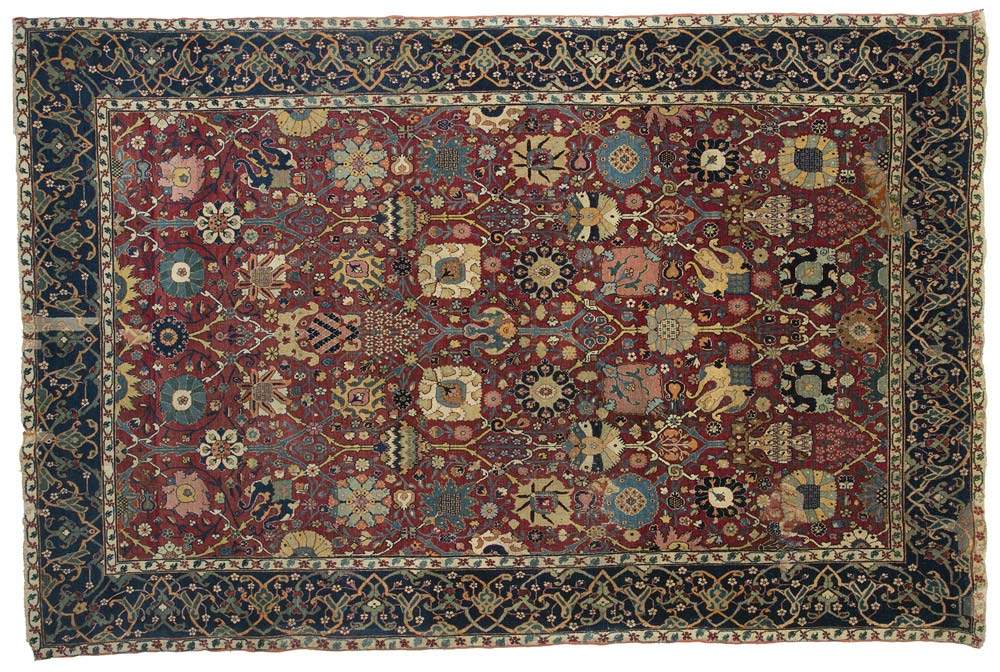Genoa, ancient Persian carpets from Kerman on display at Palazzo Nicolosio Lomellino
From Saturday, February 4 to Sunday, February 12, 2023, Palazzo Nicolosio Lomellino in Genoa is hosting the exhibition Glorious Flowers in Wool. The Art of Kerman Carpets, 1535-1750, in Italian Collections (Glorious Flowers in Wool. The Art of Kerman Carpets from 1535-1750 in Italian Collections), curated by Fondazione Bruschettini for Islamic and Asian Art with scientific advice from Michael Franses, textile art historian, research associate of the Museum of Islamic Art in Berlin and the Textile Museum in Wahington DC and chairman of Hali (HPL).
A selection of twelve important textile works produced in the Kerman area of southern Persia will be exhibited in the Bernardo Strozzi rooms on the first piano nobile of Palazzo Lomellino: four whole carpets (three dated to the 17th century and one to the 18th century) and eight fragments (all dated between the second half of the 16th century and the 17th century) from Italian collections.
This is a collection of works of great aesthetic impact and historical-artistic value, exhibited together for the first time (thanks also to the support of Moshe Tabibnia Gallery, Milan and Open Care - Services for Art in Milan, a technical sponsor) to anticipate, as a preview, the exhibition that the Bruschettini Foundation for Islamic and Asian Art is planning for the coming 2025 in synergy with the other important Italian collections that count Kerman carpets among their masterpieces.
The initiative is being held on the occasion of the international conference Kerman Carpets of the Safavid Period (1501-1736), organized in Genoa by HALI magazine, the most important international magazine dedicated to historical carpets, in memory of Alessandro Bruschettini and which will draw to Palazzo Tursi on Friday, February 10 and Saturday, February 11, 2023, the most important scholars and collectors in the field from all over the world.
Elisabetta Raffo, director of the Bruschettini Foundation for Islamic and Asian Art, said, “The initiatives are part of the long-term planning of the Foundation, which was established in Genoa at the behest of Alessandro Bruschettini: Genoa could undoubtedly once again play a central role in the world cultural scene, that same role as capital of the Mediterranean that it historically had in the Middle Ages and that today, at the center of an ideal circle between Europe, the Near East and North Africa, would lead it to represent the fundamental, and so topical, values of dialogue, interaction, exchange, enhancement and growth through culture. ’Liquid Frontiers’ and interculturality: we hope that the projects initiated in this sense with the city’s public and private institutions can continue.”
Completing the exhibition at Palazzo Lomellino are a series of panels illustrating the presence of Persian carpets in the homes of Genoese Families in the 16th and 17th centuries with a reference to the paintings made by Rubens and other artists of the time: a further affirmation of the importance of these precious furnishings in our city and the role of Genoese merchants in their spread throughout Europe.
Opening hours: Tuesday to Friday from 3 to 6 p.m., Saturday and Sunday from 10 a.m. to 6 p.m. Tickets: full exhibition 8 euros, reduced 6 euros, students and teachers 5 euros. Guided tour of the palace: full 8 euros, reduced 6 euros, students and teachers 5 euros. Ticket exhibition+palazzo and secret garden: full 14 euros, reduced 11 euros, students and teachers 9 euros. For information visit the Palazzo Nicolosio Lomellino website.
 |
| Genoa, ancient Persian carpets from Kerman on display at Palazzo Nicolosio Lomellino |
Warning: the translation into English of the original Italian article was created using automatic tools. We undertake to review all articles, but we do not guarantee the total absence of inaccuracies in the translation due to the program. You can find the original by clicking on the ITA button. If you find any mistake,please contact us.




























